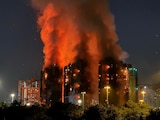Mumbai woke up to yet another smoggy morning today, with its air quality continuing to be in the poor category. To tackle the challenge, the city's civic body, Brihanmumbai Municipal Corporation (BMC), held a review meeting to assess progress on the installation of sensor-based air-pollution monitors at construction sites across the city. According to BMC officials, a total of 662 pollution-sensor units have been installed so far, with 251 more installations still underway.
Out of the installed units, 400 devices have been integrated with the central dashboard developed by CEEW. Of these, 283 sensors are active, while 117 remain inactive; the inactivity was attributed to challenges such as lack of electricity or Wi-Fi at sites, delays in fabrication work, or non-receipt of required technical data from project proponents.
The civic body has decided to compile a list of all construction sites with inactive pollution indicators and share it with the Environment and Climate Change Department. The department has been instructed to carry out physical site inspections, verify vendor submissions, and issue compliance notices in line with orders from the Bombay High Court, wherever non-compliance is found. The BMC has also warned construction firms that action will be taken against any sites found violating pollution-monitoring norms.
This comes even as the Bombay High Court dismissed claims that the recent deterioration in air quality in Mumbai was due to ash from a volcanic eruption in Ethiopia, stating that the city's poor air quality levels predate the ash cloud.
A bench comprising Chief Justice Shree Chandrashekhar and Gautam Ankhad was hearing a batch of public-interest petitions filed in 2023 related to long-standing air pollution in the city. Senior counsels appearing for the petitioners noted that the city's Air Quality Index (AQI) this month has frequently exceeded 300.
During the hearing, additional government pleader Jyoti Chavan argued that the ash plume from the eruption of the Hayli Gubbi volcano in Ethiopia had worsened air quality. The bench, however, rejected this explanation. "Even before this eruption, if one stepped out, visibility was poor beyond 500 metres," the court observed.
The court expressed concern over persistently high Air Quality Index (AQI) levels, especially over the past month, when several monitoring stations in Mumbai recorded AQI scores well above 300, repeatedly crossing the "hazardous" threshold.
Questioning the effectiveness of previous pollution-control efforts, the bench directed civic and state authorities to adopt concrete preventive measures. It stressed that what Mumbai needs is not sporadic fixes but a robust, enforceable mechanism to curb emissions from construction activities, industries, open burning, and other chronic sources.
The court questioned what effective measures have been taken so far to combat pollution, pointing out that previous efforts have failed to bring any discernible improvement. It urged authorities to adopt concrete steps, noting that while the situation in Delhi has worsened sharply, Mumbai has long grappled with poor air quality.
The matter has been posted for further hearing on Friday, with the court asking the government to submit a plan of action to improve air quality in the city.















